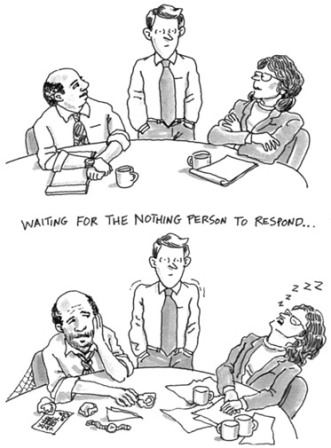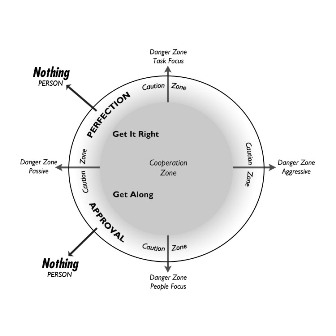
The Nothing Person

Ray walked into Sam’s office, and he sat down on the couch across from him. Sam didn’t even look up to acknowledge Ray’s presence. “Look, Sam, you can’t keep this up forever. Talk to me. Whatever it is that you’re upset about, we can work it out if you’ll just give it a chance!”
Sam continued to browse through his journal. Ray thought he saw a flicker of interest on Sam’s face, but then it passed. Impatiently, Ray shouted, “Come on, Sam! The whole project has stalled out because you’re sitting on the numbers. I can’t keep putting people off. I’ve run out of excuses and interest is flagging.”
Sam slowly pushed his chair away from his desk, rose to his feet, and started across the room. Ray, believing that a breakthrough was at hand, rose to meet him. But as Sam neared the couch, he veered to his left and walked over to a pencil sharpener on top of his bookcase. “Too bad!” he muttered.
Ray glared at him, shook his head and thought, “Why does he have to act like that? What did I do to deserve this?”
Sam is the person you find yourself waiting to hear from at one time or another. And what do you get for your patience and perseverance? Generally, nothing. No verbal feedback. No nonverbal feedback. Nothing. Mouth sealed shut, the Nothing Person stares past you as if you’re not there.
When you look through the Lens of Understanding, Nothing People’s behavior begins to make sense. Nothing People are passive, but they can be task focused or people focused depending on the thwarted intent—get it right or get along. When the intent to get along is threatened or thwarted, shy, quiet, or thoughtful people tend to withdraw and become ever more passive. Silence is, after all, the ultimate passive response. Some get along people withdraw out of their fear of rocking the boat, stirring things up, making waves, and getting thrown overboard. We all have those moments when we bite our lip and say nothing, when we convince ourselves it will accomplish nothing to speak up, when we fear that someone’s feelings will be hurt if we speak, when we stop ourselves from saying something that we’ll later regret. Everybody knows if you don’t have something nice to say, you shouldn’t say anything at all. Get along Nothing People don’t and won’t.
Get it right Nothing People seek perfection, but nothing measures up. They may decide that no one else cares about avoiding mistakes as much as they do and that nothing will change that condition no matter what they say. They get frustrated and finally withdraw with the thought, “Fine! Do it your way. Don’t come crying to me when it doesn’t work out.” Then they shut up and shut down. They can think of nothing that can be done.
Although Nothing People seem to withdraw from conflict, inside they can be a boiling cauldron of simmering hostility that occasionally boils over. Perhaps you’ve been around people who were breaking pencils or throwing them and slamming drawers and doors. When asked what’s wrong, they answer, “Nothing!” Another person asks, “Is everything all right?” and they answer, “Everything is fine,” a passive-aggressive acronym for frustrated, insecure, neurotic, and emotional. While passive-aggressive Nothing People may be furious about what’s going wrong, they are considerate enough to try to prevent their emotional hostility from damaging anyone else. This explains their abuse of inanimate objects like pencils and doors. Silence, then, can be a kind of aggression kept under wraps.

You’d Better Adjust Your Attitude
To make certain that nothing you do makes matters worse when Nothing People are at their worst, you must find a way to slow yourself down. The biggest challenge is to find and take the time when you’re in the get it done mode and there isn’t much time. Perhaps you’ve experienced the frustration of wanting to move quickly toward a goal, only to have Nothing People slow you down. That frustration can easily turn into aggressive communication, which will guarantee that you’ll get nothing out of them. And impatience with get along Nothing People, who are trying to avoid conflict and disapproval, will likely defeat your purpose and drive them further into nothingness.
That’s one of the most common mistakes parents make with their children. Nothing behavior is the best trick children have. Intense communications directed at children by frustrated parents are likely to silence the children and further frustrate the parents, who may then escalate with greater intensity, which drives the children further away. The children become too preoccupied with finding shelter from the verbal bombshells to pay much attention to what is actually being said. In the short term, nothing is accomplished, and in the long term the fallout damages the relationship.
The same principle is at work in adult relationships. If you lose your temper with people who have low assertiveness, you can count on diminishing returns in communication. Since impatience and frustration drive Nothing People deeper into nothingness, it is essential that you look and sound like you have all the time in the world. The internal resource that produces that outward appearance is relaxation. Take the time to compose yourself before attempting to communicate. To get something from Nothing People, you must be calm and relaxed.
Another helpful resource is intuition. The best way to develop your intuition is to try to see the world through another’s eyes. Another way to develop intuition is to assume a similar body posture and facial expression as another person, and then you observe your emotional state and thoughts. You may be surprised at how well you can understand and communicate with Nothing People using this method.
Your Goal: Persuade Nothing People to Talk
Regardless of why Nothing People tell you nothing, your goal is to persuade Nothing People to talk. That is not only possible but it is also probable because when you use this strategy, nothing can’t stop you.
Action Plan
Option 1. Plan Enough Time. Hostile Nothing People may push you up against your deadline. You need information badly, they’ve got it, you want it, so they won’t give it to you. For this reason, protect yourself if possible by planning ahead. Dealing successfully with Nothing People may take a long time. If you are tense and intense because of limited time, it’s the wrong time.
If you have committed yourself to open communication with people who are closed, your time allotment may have to include more than one slot on your monthly calendar. We recommend that you plan a few 15-minute “communication opportunities” with your Nothing People. That way, if at first you don’t succeed, you can keep coming back to try. Once they get the message that you are not giving up, they may open up just to get you to quit showing up.
Option 2. Ask Open-Ended Questions Expectantly. The best kind of question to ask Nothing People is one that can’t be answered with a yes, a no, or a grunt. We suggest that you use questions that begin with the words who, what, where, when, and how because they tend to open topics for discussion, with a request for specific information about Nothing People’s thoughts. For example, “What are you thinking?” and “How do you want to proceed?” and “Where shall we go from here?” have a greater chance of success than “Do you like that?” or “Are we going to get your information soon?” or “Can you tell me?”
However, it isn’t what you ask but how you ask it that makes all the difference in the world. When you ask the question, make certain that your nonverbals are also asking for a response. We recommend that you look and sound like you are about to get an answer. We call this the expectant look, and it is a nonverbal skill based on the idea that you get what you expect (even though it often takes more time than you would prefer).
Try this now if no one is looking. Raise your eyebrows, open your mouth slightly, tilt your head to the side, and lean forward a little as if you just asked a question and at any moment you expect an answer.

When you ask the Nothing Person your open-ended question, you may have to persist in looking at them expectantly for a longer period of time than you would with normal human beings. It may help you to pass the time if, in your mind’s eye, you imagine that you can see the words marching up the back of their throat, through their mouth, and out to the tip of their tongue, where—any second now—they are going to open their mouth and give you that answer!
Beware: You won’t want this to become a staring match. If at first you don’t succeed, review what’s happened so far, which isn’t much, and then, ask your question again. Here’s an example. “A moment ago I asked you what’s going on, and you didn’t answer. I’m still wondering, what’s going on?”
At last, the pressure builds to a point where the Nothing Person feels compelled by your behavior to answer you. You see their mouth open, and out comes the typical response, which is “Nothing” or “I don’t know.”
If a Nothing Person says “Nothing,” then you can say “What else?”
If the Nothing Person says “I don’t know,” then you can say “Guess!” or “Make something up!” or “If you did know, what would it be?” Give the Nothing Person your best expectant look. You will be surprised at how effective this can be with both adults and children. Try it the next time anyone says, “I don’t know.” It is amazing how quickly people come up with something to say, only moments after claiming that they knew nothing.
Option 3. Lighten It Up. When nothing else is working, a little humor carefully used can go a long way. Making absurd, exaggerated, and impossible guesses about the cause of the silence has cracked a smile and broken down the armor of some of the most intransigent Nothing People you can imagine. If you can get Nothing People to laugh, it ruins the mood.
Your next line of offense against an “I don’t know” could be exaggeration. At a couples seminar, a participant claimed her husband left too many glasses in the sink. We asked her, “How often and how many?” To which she replied, “Too often and too many.” We laughed and asked for a number, and she said, “I don’t know.” We were ready for that, and we asked her to guess, and then we gave her our very best expectant looks. She couldn’t resist the look and said (again), “Too often and too many.” Since we’re convinced that if what we’re doing isn’t working, we should do something else, that’s what we did. We exaggerated: “Well, would you say it is 30 glasses a day seven days a week, 52 weeks a year?” And she said, “No, it is probably about 4 glasses, three times a week.” We had to wonder, “Where were those numbers a moment ago?” We still don’t know, but we do know that if you exaggerate, people get specific.
Or you might begin guessing yourself. You could say, “You’re mad because I beat you to the watercooler and it’s a full moon, right?” Or you could say, “I’ll talk, and you blink once for agreement, twice for disagreement.” We’ve found that with some Nothing People, the more outrageous your guesses and suggestions, the sooner they will speak up and get specific.
Be careful with this because humor is a two-edged sword. It can inadvertently cut Nothing People and yourself, and there’s nothing funny about that. Consider yourself warned. If you proceed to use humor and Nothing People take offense, don’t keep trying to make light of what has become a serious situation. Apologize immediately and sincerely. Then remind them that your intent is to have a dialogue, not a monologue. Like many kinds of communication, the use of humor is not guaranteed to work in every situation. It is a judgment call on your part, so use it with caution.
Option 4. Guess. If the Nothing Person remains silent and nothing else has gotten results, or you want an alternative to Option 3, try this: Put yourself in the Nothing Person’s shoes, and think back on the course of events as you understand them. What was the sequence, and how else might you interpret that sequence to make positive sense out of this negative silence? Once you’ve come up with an idea, suggest it to the Nothing Person, and watch for a reaction. You may think of several possibilities. Just rattle them off. Don’t worry about trying to figure out the right one. It won’t matter if some of them are inaccurate, so shotgun a bunch of them. Always preface your guesses by saying, “I don’t know what is going on for you” or “I am just guessing here, but ...” People hate to be told that you know what they are thinking, but they love it when you guess correctly. If you can hit on or near the reason for the silence, you may actually get these people to start talking. At least you’ll notice a definite change in their posture or expression.
A state agency referred Becky, a troubled teenage client, to a counselor named Gideon. Becky had dropped out of school, was sleeping all day, and wouldn’t talk to anyone—including the counselor. She just sat in his office, shaking her foot, and staring out the window. She wouldn’t answer any of his questions. Worst of all, she was ignoring his very best expectant look.
So the counselor started guessing about the cause of her behavioral change. He said, “I don’t know what is going on for you, and you certainly aren’t going to tell me, but you’ve got me wondering. If I were a teenager, sleeping all day, what would be going on for me? Hmm, I think I would be avoiding something! Well, what would I be avoiding? Maybe something at school, maybe something at home. At school, let’s see. Maybe I wouldn’t fit in, maybe I don’t have any real friends, maybe I think the whole clique thing is dumb. The state urges me to go back to school, but maybe I’m so far behind I will never be able to catch up. Maybe I am missing some basic reading and math skills that I am embarrassed about.”
Gideon continued, “Now, what could I be avoiding at home? Maybe I don’t feel cared about. After all, if I dropped out of school and I was sleeping all day but my parents didn’t say anything, well, I guess I’d figure they just didn’t care very much. After all, it’s the state that’s making the big deal out of it. And I heard you do have a new step-parent. I can sure see how you would feel left out of that relationship.”
How did Becky respond to this guessing game? On the counselor’s second guess about school, her foot stopped wiggling. That was a good sign because it was the first change in her practiced nothingness in 20 minutes. As Gideon continued, Becky looked up and locked her eyes on his. Then tears welled up in her eyes. And within moments, she was speaking the fears that had been hiding in her heart.
If you notice a change in behavior while you’re guessing, that’s an indicator that you’re on the right track. Continue along the same lines, and before you know it, they will be talking with you. Best of all, even if your guesses miss, people sometimes start talking anyway. It’s as if they feel sorry for you because you haven’t got a clue about what is really going on, and they decide to give you a break. By walking a mile in the footsteps of another, you reveal the common ground of your humanity.
Option 5. Show the Future. Sometimes, the only way to get Nothing People talking is to take them out of the moment and into the future. There they can see the consequences of continued silence, and perhaps they can find enough perspective and motivation to open up. The actual words you use may change depending on your relationship to the Nothing Person:
• For the get it right Nothing Person, you might say: “Fine, don’t talk. [Blending with what is happening] Just imagine how many things can go wrong and how much time we are going to waste on this project because we didn’t have your input.”
• For the get along Nothing Person, you might say: “Okay, you don’t have to talk [Blending], but in the long term I don’t see how our relationship can survive if we don’t start to communicate.”
• For the get along Nothing Person at the office, you might say: “Okay, you don’t have to talk [Blending], but it sure won’t be any fun to work around here if we are all in our own little worlds. That will certainly kill the team spirit and make for a lot of bad feelings and misunderstandings.”
• For the hostile Nothing Person who is trying to “get you” by closing you out, talk about the negative consequences, like grievance procedures, going over their head, filling out paperwork, and the like.
Warning: Don’t make promises you won’t keep. Idle threats teach people that you’re idling. Your goal is to make something out of nothing, not nothing out of something, so that it becomes uncomfortable for Nothing People to remain silent.
Sometimes, when a Nothing Person finally does speak up, you may find that it’s a case of “all or nothing.” If you get a lot of seemingly disconnected information, instead of interrupting for clarity’s sake, go with it for a while, so they can get used to talking aloud. Don’t try to control it. When Nothing People start talking, that’s when you need to start listening.
Great Moments in Difficult People History

The Power of Persistence
Ray fought the urge to leave. Instead, he relaxed and told himself he had the time and this was worth it. He seized upon this scrap of verbiage, and he returned it in a question: “What’s too bad, Sam?” [Ask open-ended questions expectantly]
Sam looked at Ray with eyes of steel. Those eyes seemed to soften for a brief instant. Then, he braced himself and replied, “I don’t know.” Sam returned to his desk and his journal.
Ray said, “If you did know, what would it be?” [Ask questions expectantly]
Sam looked away, and after a moment of silence he said, “I don’t see how anyone thinks we can do the job around here the way we were treated. It’s just ...” he muttered and faded out into silence again.
Ray sat there mentally reviewing recent events at the company, and that’s when it dawned on him.
“Sam, I’m just guessing here, but three months ago during the reorganization, two of our departments were downsized significantly, and budgets were axed. What effect did that have you?” [Guess] Ray saw Sam’s body language go through an incredible shift. Sam was practically squirming in his seat, and it looked like the pressure was building inside him to speak. But again, Sam braced himself, and he glared steely eyed at his journal.
Ray felt that Sam needed a little motivation to open up and talk about whatever had caused him to go silent. So Ray spoke to the future, as he said, “If I’ve guessed right about this, and you found that shrinking budget and loss of personnel to be tough to deal with, then think about this! Without that information you’re withholding, more people will lose their jobs, and people right here in this company who you’ve known for years are going to have their futures put at risk, all because you didn’t do the right thing. You may think you have a good reason for being silent now, but how will that reason of yours hold up later? [Show the future] Come on, Sam. What’s going on?”
Sam opened the flood gates, and a torrent of bad feelings and apprehension washed through the room. It was obvious that Sam had been suffering in his silence. Ray let him talk. And when it was all said, Sam yielded the badly needed information like a shy little boy. Ray, happy to have brought a little light to the situation, thanked him for his honesty and left him alone with his thoughts.
The Great Foot Fire
The speaker was brought in by a state agency to give a motivational presentation to eight of their most hopeless cases. None of the speaker’s audience involvement strategies was working very well. As far as these teenagers were concerned, he was just another authority figure, and when he looked around the room, all he saw were eight hostile Nothing People with no interest in hearing a word of it. He had his back to the writing on the board when he suddenly smelled smoke. He turned around to find their ring leader, Eric, grinning at him. Eric had set his own shoe laces on fire. The laces were burning like incense, and the teenager was sitting there with his legs crossed, grinning.
The speaker didn’t want to be another authority figure in a long line of authority figures whom these kids had rebelled against. So instead, he looked the boy right in the eyes, smiled, and said, “I heard you were hot but you’re smokin’ today, dude.” [Lighten it up] Then the speaker went back to writing on the board, picking up where he left off as if everything were normal. The kids all laughed, and the boy put out the fire. When the speaker turned around again, he had eight allies who were ready to participate and learn.

Quick Summary
When Someone Becomes a Nothing Person
Your Goal: Persuade the Nothing Person to Talk
ACTION PLAN
1. Plan enough time.
2. Ask open-ended questions expectantly.
3. Lighten it up.
4. Guess.
5. Show the future.